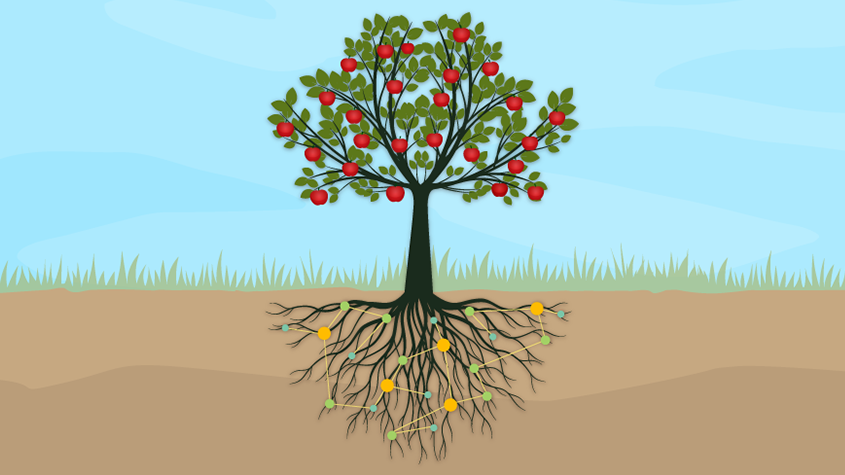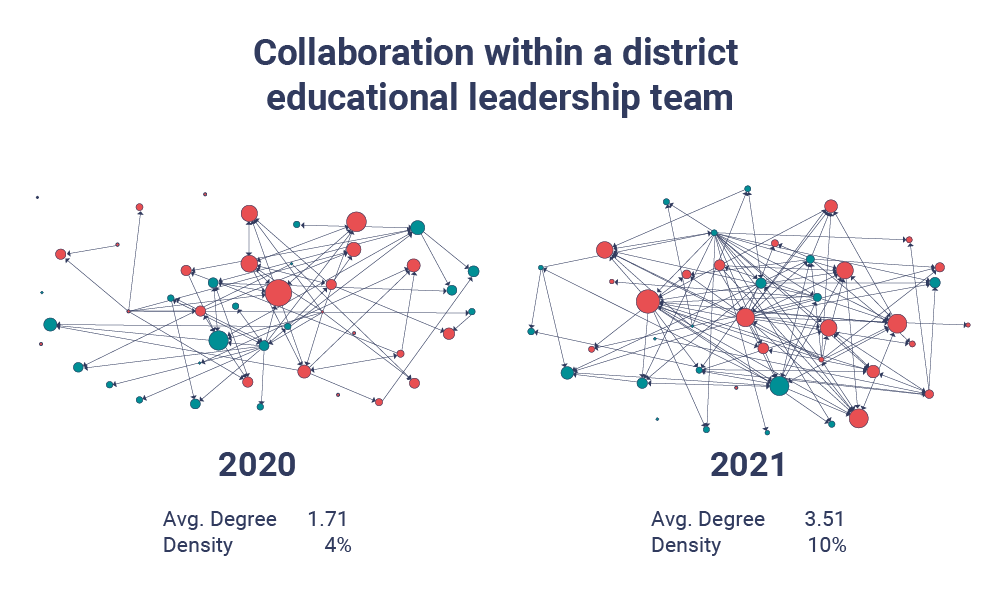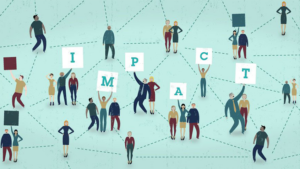
Rethinking social networks for equity, excellence and flourishing
Researchers in social network theory and educational leadership provide an analysis of how SVA’s The Connection is using networks to improve education outcomes within communities experiencing disadvantage.

- Social Network Theory (SNT) is a way of understanding the connections between individuals in (and across) organisations to understand how they connect and communicate.
- Research suggests that social networks in education can improve both individual and collective performance.
- An evaluation of SVA’s Bright Spots Schools Connection (The Connection) conducted by researchers at RMIT University found that The Connection has improved education across member schools in several respects. Also the authors own emerging research suggests that teachers and administrators taking part in The Connection are benefiting from stronger social networks and importantly high levels of flourishing.
- The Connection offers an excellent example of key aspects of SNT including understanding the informal structure of organisations, how the individual influences the group and the group the individual, and under-utilised expertise and resources. It also shows how SNT helps identify influential actors, information and expertise ‘hubs’.
- SNT studies could help organisations, businesses, and government entities in other sectors better understand how resources, talent and information flow in, into, around and beyond their organisations.
Over the past 20 years, the Australian education system has experienced a steady decline in performance on internationally normed tests measuring mathematics, reading and science.1 In late 2019, the release of results from the 2018 Programme for International Student Assessment (PISA) indicated that the country had not reversed this trend and Australian students may indeed be falling even further behind peers from around the world.2 While scores on internationally normed tests are a limited way to measure the strength of an education system, these results are nonetheless concerning.
In addition, Australia has a pronounced achievement and opportunity gap – wherein students in affluent urban and suburban schools are more likely to have access to an abundance of high-quality educational opportunities than those in remote, regional, rural and economically disadvantaged areas.3 This opportunity gap is even more pronounced when comparing Indigenous Australians to non-Indigenous students.4 This decline has widespread implications for Australian society and despite previous efforts to improve the situation, it demands urgent attention and innovative action from the country’s policy makers and educators. For the previous two years, Australian education has faced additional pressures in the form of the Covid-19 pandemic. Educators have responded well to the challenges in difficult circumstances, however the OECD has indicated that there are likely to be detrimental long-term effects to student learning, emotional wellbeing and timely career/educational progression.5
… states have recognised that networks are a central part of the solution.
To be sure, Australian education as a whole has worked hard to move results in a more positive trajectory. During this time, national policy initiatives such as the Melbourne Declaration on Educational Goals for Young Australians6 guided and complemented many schools and school systems that responded with initiatives designed to improve the nation’s educational processes and outcomes. Due to the federal structure of education in the country, many programs are designed at the national level, but are then implemented at the state level, meaning that many education reforms are driven by state education strategies and practices and are shaped by local dynamics.
States and schools have initiated many ambitious efforts to improve education over the past several decades, including changes to pedagogy, technological advances and improvement in school facilities, among others. Yet despite variation across locales, one of the central features of each Australian state’s education strategy is improving the nature and quality of interactions between students, teachers and principals and re-examining the nature, frequency and purposes of these connections – put simply, states have recognised that networks are a central part of the solution. Such efforts are meant to establish or enhance social and professional networks focused on teaching, learning and leadership so that high-quality and effective educational skills, knowledge and strategies benefit the entire school system rather than just an individual, classroom or a single school.
Networking
Networking activities take place at two levels, within schools and across schools. These efforts are commonly manifest within schools as professional learning communities, grade level and vertical teams, peer mentoring/tutoring programs, enrichment programs, and ability-level grouping, among others. At the departmental level, each state has worked to enhance student, teacher and principal networks across schools as a complementary improvement strategy. Such initiatives include professional development programming, networking events, digital and geographical teacher networks, school-partnership arrangements, and a variety of other activities. At present, there are limited cross-jurisdictional networks (Social Ventures Australia’s The Connection is one notable exception) that could harness the natural experiments in different jurisdiction. These approaches to improving the collective through high-quality networked interactions are meant to facilitate the sharing of best-practices in teaching, learning and leadership, and they represent an important and promising shift in Australian education – a shift away from a focus on human capital (training individuals to improve their practice) and toward a focus on social capital (creating networks that learn and share within and across schools).
… social networks can also potentially increase participants’ sense of flourishing, a feeling of mental wellbeing…
Research suggests that social networks in education can improve both individual and collective performance and they have proven particularly effective in improving mathematics, science and reading processes and outcomes.7 In Australia, there is a need to better understand the social networks that have already been created to improve schools, and to understand how these can be best directed toward improving excellence (student performance and achievement), and equity (creating opportunities and access by sharing ideas and resources throughout the country). Sadly, both excellence and equity are a concern across the sector – in urban centres, suburban contexts and in rural, regional and remote schools and communities. Additionally, recent research from other sectors suggests that social networks can also potentially increase participants’ sense of flourishing, a feeling of mental wellbeing allied with high levels of job satisfaction and productivity.8 While there are many education networks throughout Australia, we focus our attention on a program gaining attention around Australia for addressing equity, excellence and flourishing – SVA’s The Connection.
The Connection: improving schools through networks
SVA launched the Bright Spots Schools Connection (The Connection) in 2014 as a way of helping schools address inequities by connecting them in networks to share teaching, learning and leadership strategies. An initial cluster of eight schools who achieved remarkable success9 in challenging circumstances in Victoria and New South Wales, has since expanded to 50 schools and now includes schools in South Australia as well. Teachers and administrators are engaged in ongoing networked professional learning activities designed to help educators make the most of existing resources while also learning about new ways of thinking and working. This day-to-day work is punctuated by various events (see the model): thought leadership gatherings (two day national conferences held three times yearly), hub days (one day localised events held termly) and Connection international explorations (periodic optional international visits to sites of best practice) – each of which is designed to increase the flow of information and expertise into each school and share building-level strategies out to the rest of the network.
Additionally, schools are supported by a relationship manager to identify, action, and measure progress of a priority school initiative over three years.
The Connection has enabled new educational practices to flow freely across the entire network.
An evaluation of The Connection conducted by researchers at RMIT University found that The Connection has improved education across member schools in several respects.10
First, The Connection has enabled new educational practices to flow freely across the entire network. This is significant in that typically schools improve one classroom at a time or one school at a time, but the systems approach of The Connection has meant that each school benefits from innovations and effective strategies developed anywhere in the network.
Second, in addition to a freer flow of ideas, effective practices are much more quickly developed, tested and adopted than previously. Educators are aware of effective practices much more quickly, as The Connection has created an outstanding communication infrastructure and sound practices for sharing positive results across the schools.
Finally, The Connection has also helped schools prepare for and initiate change more effectively than before. Change processes in schools are always difficult to manage, but it appears that The Connection’s attention to making a difference both in the day-to-day life of each school and the dissemination of ideas and best practices via thought leadership gatherings, hub days and Connection international explorations have meant that change is an ongoing part of the ways that the schools operate rather than a separate process outside of working norms. Schools in The Connection have seen improved student engagement, student learning and development, STEM-related learning, student voice and agency, metacognition and general capabilities.11
… not only helping students achieve greater levels of outcomes in attendance, engagement, perceptions of their learning… but also enabling teachers and administrators to find their work even more exciting, engaging…
In addition to these educational outcomes, our own emerging research suggests that teachers and administrators taking part in The Connection are benefiting from stronger social networks and importantly high levels of flourishing – a psychosocial construct that combines wellbeing and high levels of work performance. While our findings are early, it appears that engagement in activities and networks offered by The Connection are not only helping students achieve greater levels of outcomes in attendance, engagement, perceptions of their learning, and a lower number of behavioural incidents,12 but are also enabling teachers and administrators to find their work even more exciting, engaging and are themselves delivering teaching, learning and leadership at heightened levels. In addition, the relationships and networks that are formed within The Connection are providing the opportunity for high quality knowledge and resource flows between and among educators.
While these positive results indicate that The Connection is an effective program, one question remains – what makes The Connection an effective network? In order to form an answer, we turn to Social Network Theory to help us understand how networks work, what their potential might be for improving education, and ultimately consider how these lessons might be translated across to other sectors.
Exploring how educators and schools are connected: Social Network Theory
Social Network Theory (SNT) is a way of understanding the purpose and practice of networking within and across organisations and into community and government sectors. SNT provides insight into how the social processes and outcomes involved in change are stretched across individuals and levels of a social system.13 When we look at people and organisations via SNT, we can ‘map’ the connections between individuals in (and across) organisations to understand how they connect and communicate. For example, we might be interested in learning who shares resources, who teachers turn to for professional advice, or whom they turn to for certain types of expertise. This approach provides the opportunity to reveal how an organisation is structured in practice, rather than how it looks in a traditional organisational diagram. See Figure 1.

Unlike fixed formal systems, we also know that our social ties are dynamic and as such can change over time.14 Perhaps more important for those of us interested in change and growth in organisations, social networks are also responsive to intentional and strategic intervention as shown with a district educational leadership team in Figure 2.

Such analyses as noted in Figure 2 indicates strengths and areas to grow in social systems whether these be between leaders as shown or in grade levels or instructional teams. It can reveal ‘hubs’ in schools and systems where many people turn to for support and can help us see patterns of behaviour we may not otherwise identify. This in turn can help teachers and leaders make decisions about re-organising parts of the organisation, supporting certain areas more (or less) robustly, and reveal if current communication and workflow strategies are effective.15
With respect to understanding educational practice using social network theory, The Connection offers an excellent example of certain key aspects of SNT.
Social Network Theory helps us understand the informal structure of organisations as illustrated in Figure 1. Schools are knowledge organisations where there is a great deal of information and expertise distributed throughout the organisation. SNT helps us locate the influential actors throughout the system, regardless of their position or rank in an organisation. With regard to The Connection’s work in schools, this has enabled school leaders to discover influential educators in their buildings and then support them to make a positive difference beyond the classroom and across the network.
Social Network Theory helps us understand how the individual influences the group and how the group influences the individual. The work of the Connection has demonstrated that with proper experiences, training and support, leaders can influence the day-to-day practices in their schools in a positive manner, leveraging what they have learned and practiced in program activities to improve classroom practice. Further, there is evidence that participants call on their Connection colleagues between sessions for advice and ideas, and that many schools have established ongoing partnerships around certain key issues. This shows the two-way benefit of involvement in The Connection – individuals benefit and learn, while they also provide the same to others throughout the multi-school network by sharing their own expertise.
Social Network Theory helps us identify influential actors, information and expertise hubs in networks despite their rank or position in the organisation. The Connection has shown that it can support and identify expertise and excellence in various parts of the network, and then act to enrich the network by sharing this expertise strategically. A traditional organisational chart does not always identify the people or teams in an organisation with specialised expertise and a willingness to share. Social network theory helps us understand how people are connected – not through lines of authority, but rather by the nature of their work and knowledge, and this can stretch across the entire network, not only within one school. In essence, quality teaching practices that formerly benefitted one school now benefit schools throughout The Connection. Importantly, this suggests that The Connection has the ability to leverage expertise in schools to improve educational processes and outcomes in schools facing difficult challenges.
Social Network Theory helps us understand under-utilised expertise and resources. As SNT helps us identify strong parts of our networks, it also helps us identify places throughout the network where ideas, resources and strategies are not shared effectively. This provides leaders with direction about areas of the school where communication and collaboration can improve. Critically, the resources to address these shortcomings can be drawn from the entire Connection network – as such, the capacity of these schools is not only the people in the building, but also teachers and leaders throughout Australia. The scope and nature of this network is potentially revolutionary to the provision of education in Australia. While it may benefit many types of schools, it is particularly encouraging as an untapped practice to support under-resourced schools, and schools in regional and remote Australia.
Improving social networks in education and beyond
The Connection is an example of effective social networking as a way to improve education. Since 2014, The Connection has grown in terms of both the number of schools involved and also with respect to the variety and location of schools it serves. Evaluations and emergent research indicate that The Connection offers both educational and wellbeing benefits for teachers and administrators, and it has shown that it has the ability to bring new resources to communities experiencing disadvantage, thereby improving issues of access, opportunity and equity.16 Despite these successes, more research and further development is needed to help The Connection achieve its potential and broaden its reach throughout Australia, and possibly beyond as it links into international efforts to improve education through social networks.17 This will mean linking network activity to student experiences and achievement, investigating implementation of shared practices and studying the network over time. Indeed, while the next steps for The Connection are surely about capitalising on successes and navigating the inevitable complications that come with scaling up a complicated and multifaceted program, there are additional issues to consider.
… all sectors should be more intentional and systematic in how they shape and support social networks.
The Connection, and SNT in general underscore the need to rethink our connections within and across organisations and society. If schools can improve performance and enhance people’s sense of flourishing by carefully planned networking activities, the implications across other sectors are extensive. Social Network Theory studies in medicine, political science, sociology and in other disciplines likewise suggest that thoughtfully expanding networks – and carefully studying them as they develop – are likely to open a wealth of opportunities to improve equity through Australia and beyond.18 19 Such research and development would help organisations, businesses, and government entities better understand how resources, talent and information flow in, into, around and beyond their organisations.20 While educational efforts such as The Connection have shown the potential of social networks for improving practice in education, such a program also emphasises that all sectors should be more intentional and systematic in how they shape and support social networks. By using social network theory to understand the ways we are connected, and by putting programs like The Connection in place as well as studying how they function, grow and realise goals for excellence and equity, the possibilities for improvement within and across organisations, sectors, and indeed around the world open wide.
Authors: Professor Alan J. Daly & Professor Jeffrey Brooks
About the authors
Alan J. Daly, Ph. D is a Professor and the Director of Educational Leadership Doctoral Programs in the Department of Education Studies at the University of California, San Diego. Influenced by his 16 years of instructional and leadership roles in public schools, Daly’s research primarily focuses on the role of social networks, leadership, educational policy, and knowledge mobilisation and the relationship between those elements on the educational attainment of traditionally marginalised student populations. He was most recently the Chair of the Department of Education Studies and a Fulbright Global Scholar in New Zealand and South Africa.
Jeffrey S. Brooks is Head of School and Professor of Educational Leadership in the School of Education at Curtin University. He is a two-time J. William Fulbright Senior Scholar alumnus who has conducted studies in the United States, Australia, Thailand, Indonesia, the Philippines and other cross-national contexts. His research focuses broadly on educational leadership, examining the way leaders influence (and are influenced by) dynamics such as racism, globalization, social justice, student learning and school reform.
1 Morsy, L., Khavenson, T., & Carnoy, M. (2018). How international tests fail to inform policy: The unsolved mystery of Australia’s steady decline in PISA scores. International Journal of Educational Development, 60(C), 60-79. Chicago
2 Thomson, S., De Bortoli, L., Underwood, C. & Schmid, M. (2019, December). PISA 2018 in Brief I. Student performance. Australian Council for Educational Research. https://research.acer.edu.au/ozpisa/34
3 Ornstein, A. C. (2010). Achievement gaps in education. Society, 47(5), 424-429.
4 Ford, M. (2013). Achievement gaps in Australia: What NAPLAN reveals about education inequality in Australia. Race Ethnicity and Education, 16(1), 80-102.
5 OECD (2021), The State of Global Education: 18 Months into the Pandemic, OECD Publishing, Paris.
6 Barr, A., Gillard, J., Firth, V., Scrymgour, M., Welford, R., Lomax-Smith, J. & Constable, E. (2008). Melbourne declaration on educational goals for young Australians. Ministerial Council on Education, Employment, Training and Youth Affairs.
7 Daly, A. J. (2010). Social network theory and educational change. Harvard Education Press.
8 Gudka, M., Gardiner, K. L., & Lomas, T. (2021). Towards a framework for flourishing through social media: a systematic review of 118 research studies. The Journal of Positive Psychology, 1-20.
9 Australian Council for Education Research (2018), Evaluation of the Bright Spots Schools Connection
10 Singhania, A., Hard, N., & Bentley, T. (2020). Unleashing the power of the collective in education: The impact evaluation of SVA Bright Spots Schools Connection. RMIT University.
11 Ibid
12 Corbyn, E. (2021, September). Tapping into the power of the collective. Australian Educational Leader, 42(4), 64-67.
13 Daly, A. J. (2010). Social network theory and educational change. Harvard Education Press.
14 Daly, A. J. & Finnigan, K. (2010). The Ebb and Flow of Social Network Ties between District Leaders Under High Stakes Accountability. American Education Research Journal. Volume 48: 39-79.
15 Daly, A. J. (2012). Data, Dyads, and Dissemination: Exploring Data Use and Social Networks in Educational Improvement. Teachers College Record. Volume (114) 11.
16 Singhania, A., Hard, N., & Bentley, T. (2020). Unleashing the power of the collective in education: The impact evaluation of SVA Bright Spots Schools Connection. RMIT University.
17 Daly, A. J. (2010). Social network theory and educational change. Harvard Education Press.
18 Ibid.
19 Krause, J., Croft, D. P., & James, R. (2007). Social network theory in the behavioural sciences: potential applications. Behavioral Ecology and Sociobiology, 62(1), 15-27.
20 Merchant, G. (2012). Unravelling the social network: theory and research. Learning, media and Technology, 37(1), 4-19.







